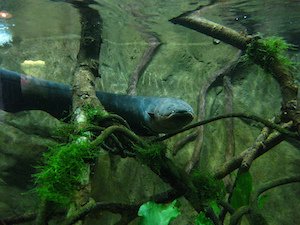
When you think about electric eels, it’s easy to picture them gliding through clear oceans, but that’s a common misconception. Instead, these intriguing fish primarily reside in rivers, swamps, and flooded forests. Let’s dive deeper into their habitats and discover not just where they live, but also how they thrive in their environments.
Electric Eels: A Quick Overview
Before we get into their habitats, let’s quickly review what makes electric eels unique. These fish can grow up to 8 feet long and weigh around 110 pounds. They have a long, cylindrical body that allows them to navigate their watery homes with ease. Their capability to produce electricity comes from specialized cells called electrocytes. When these cells align and discharge, they can create a shock of up to 600 volts, enough to stun prey and even deter predators.
You might be wondering how these eels generate electricity. Well, they don’t constantly zap everything around them. Instead, they use their electric capabilities in short bursts. They primarily utilize low-voltage signals for communication and navigation, while higher voltages come into play when they’re hunting or feel threatened.
Natural Habitat of Electric Eels
Electric eels are primarily found in the Amazon Basin of South America, where the rivers and swamps create perfect conditions for them. They enjoy slow-moving or standing waters that allow for easy hunting and maneuverability. Common habitats include:
- Rivers: These are the primary homes for electric eels, especially in the Amazon and Orinoco River basins.
- Swamps: They thrive in swampy areas, where their electric abilities can help them navigate through murky water.
- Flooded forests: When the rainy season arrives, these eels can often be found in forests that have temporarily become submerged.
What’s interesting is that electric eels can also adapt to some upstream river environments, where the water is clearer but can still be shallow. However, they shy away from fast-moving currents, as they prefer the calmer waters where they can stalk their prey more effectively.
Climate Conditions for Electric Eels
You might be curious about the climate these eels prefer. Electric eels thrive in warm, freshwater environments. They typically inhabit areas where the temperature ranges between 20-30 °C (68-86 °F). This warmth is crucial because it supports their metabolism, which is vital for their survival.
The Amazon Rainforest, for instance, provides an ideal climate, with consistent rainfall and temperatures. These factors lead to rich biodiversity, allowing electric eels to find various prey, including smaller fish and even amphibians. It’s fascinating how these fish have adapted to such a vibrant ecosystem!
Behavior and Adaptations
Electric eels have some interesting behaviors that help them survive in their habitats. Their electric discharges not only assist in hunting but also play a role in social interactions. For example, during mating season, males and females may use low-voltage signals to communicate effectively. It’s like having an underwater conversation!
Their bodies are also adapted for life in freshwater. With a long, streamlined shape, they can glide effortlessly through water. Additionally, they have a modified swim bladder that functions like a lung, allowing them to surface for air every 15-20 minutes. That’s right—despite being fish, they need oxygen just like we do!
Challenges Facing Electric Eels
Unfortunately, the habitats of electric eels are under threat. Human activities such as deforestation, pollution, and dam construction can disrupt their natural environments. For instance, dams can alter water flow and temperature, making it harder for electric eels to hunt effectively. Additionally, pollution can contaminate their waters, affecting their health and, ultimately, their populations.
Conservation efforts are essential to protect these unique creatures. Understanding their habitats and the challenges they face can help develop better strategies for preserving their ecosystems.
In summary, electric eels are incredible creatures that call freshwater environments home, primarily in South America’s Amazon Basin. They thrive in warm, slow-moving waters, adapting beautifully to their surroundings. Their unique abilities make them fascinating to study, but they also face significant challenges due to human impact on their habitats.
As we continue to learn more about these amazing fish, we can take steps to ensure their survival for future generations. So next time you think of electric eels, remember that these shockingly clever fish have a rich life far from the ocean waves, thriving in the enchanting world of rivers and forests.
